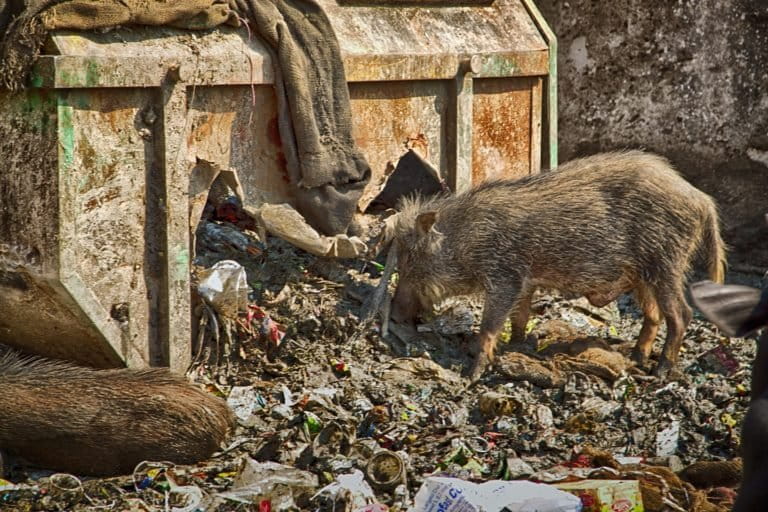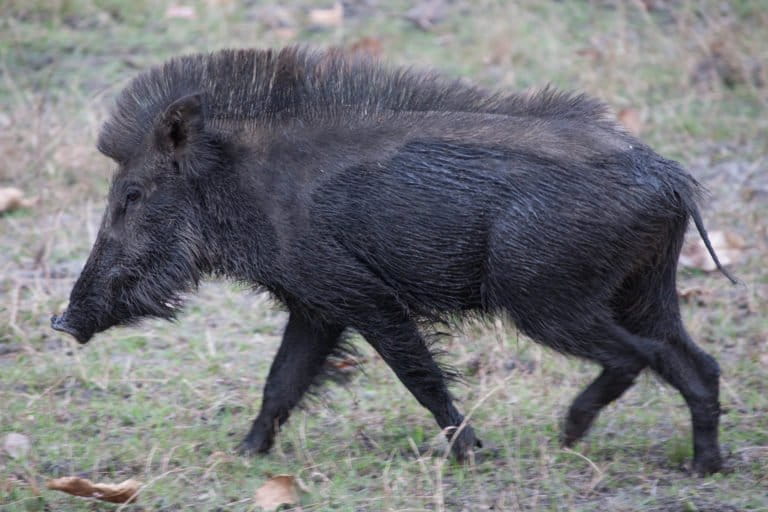- In July, Goa Chief Minister Pramod Sawant initiated the process to declare the wild boar as vermin in the state. Previously, Uttarakhand and Bihar have declared the wild boar as vermin too.
- The wild boar regularly enters farmlands in these states, significantly damaging crops and this is leading to growing conflicts between the species and humans.
- Scientific research and stakeholder commitment are key to the development of appropriate and sustainable strategies for both resolving the problem and conserving different ecosystems and their wildlife inhabitants, indicate experts.
Over five years ago, farmers groups in Goa proposed that four species – the Indian wild boar (Sus scrofa cristatus), rhesus macaque (Macaca mulatta), gray langur (Presbytis entellus) and the Indian porcupine (Hystrix indica) – be declared as ‘vermin’, a category that the government can assign to certain wild animals that have become a significant nuisance to croplands and human life. In July this year, the Goa Chief Minister Pramod Sawant acceded to one of their requests by initiating the process to declare the wild boar as vermin and directing the forest department to expedite the process because of the problems that people were facing because of it.
“As per the IUCN, the wild boar is listed under the ‘least concern’ category, while it is under Schedule III of Indian Wildlife Protection Act 1972. So yes, it is a protected animal. But Section 62 of the Wildlife (Protection) Act empowers the Central government to issue notifications declaring any wild animal, other than those specified in Schedule I and part II of Schedule II, as vermin. Only when it is declared as vermin can the wild boar be hunted and killed without any legal consequence,” Vinay Kamath, a conservationist, told Mongabay-India. Goa is not the first state to go down this route. The governments of Uttarakhand and Bihar declared the wild boar as vermin in 2016.
Boars are prolific breeders
Wild pigs are widely distributed in North Africa, Europe and Asia. At present, there are 16 species of wild boar and wild pigs worldwide. What is found in India is a sub-species of the Eurasian wild boar and is widely seen across the country. A major reason for their large population is that they are prolific breeders and breed throughout the year.
“The female boar will give birth to a dozen young ones who grow up fast, and almost all survive to adulthood. This can result in a population explosion within a short time. Wild boars do not need forests to thrive and do very well in rural areas. They are nocturnal by nature. They live on the edge of farms in burrows, where they rest during the day. They visit the farms at nights, mostly to eat tubers and plantain,” says Kalyan Varma, a conservationist and wildlife filmmaker.
Growing conflict
Over the years, a set of global trends has contributed to the escalation of human-wildlife conflict worldwide. According to the Human-Wildlife Conflict Worldwide: Collection of Case studies, Analysis of Management Strategies and Good Practices, a report published in 2005, these trends or reasons can be grouped into human population growth, land use transformation, habitat loss of wild species, degradation and fragmentation, growing interest in ecotourism and increasing access to nature reserves, increasing livestock populations and competitive exclusion of wild herbivores, abundance and distribution of wild prey, increasing wildlife population as a result of conservation programmes, climatic factors and stochastic events.

In India, specifically, there have been growing instances of vertebrate pests such as rodents, wild boars, blue bulls (nilgai) and monkeys plundering crops and causing huge damage to the farming community. They pose a danger to the farmers of both small-scale subsistence agriculture and international agribusiness. This is also the leading cause of human-animal conflict.
The wild boar, in particular, has become a regular menace for the farming community in India. There has been a rise in the number of cases of human injury and crop damage due to growing conflicts between the animal and humans. “One main reason why they are detested is because they dig up the roots of the crops. One group of wild boars can devastate a small farm overnight and the damage is irreversible. In India, a large number of farms are less than one hectare. So, such damage can result in loss of livelihood,” says Varma.
As a result, wild boars are often killed by the farmers. Poaching of wild boar also occurs frequently in the Western Ghats where wild boars are in large numbers. “Though their meat is officially banned, it is considered a delicacy in some states. So, they are hunted for it too,” says Kamath.
Sustainable strategies
All animal-human conflicts have similar causes and impacts. Scientific research and stakeholder commitment are key to the development of appropriate and sustainable strategies for both resolving the problem and conserving different ecosystems and their wildlife inhabitants.
Kamath says that while controlling the wild boar population is essential in urban areas, one has to be careful in rural and forest areas so that their numbers don’t dwindle to such an extent that their main population is impacted. “This could have an impact on the predators who feed on them. And whatever method is employed for population control, it needs to be undertaken with strict guidelines and continuous monitoring of forest department officials. Forest officials should also organise regular training and awareness campaigns for farmers in conflict areas on various recent mitigation to reduce man-wild boar conflict. Compensation amount also should be provided to the affected farmers by the state governments without undue delay in disbursement. These small steps could go a long way in reducing conflict,” he says.

Co-existing with wild boars is possible as seen in Tamil Nadu’s Krishnagiri district, where a few locals have come up with humane strategies to reduce the human-wild boar conflict in the area. Thiru M. Anand, a 47-year-old vegetable grower, says, “We avoided live wires. Instead, we opted for solar fencing around our cultivated lands which delivers a brief yet fierce shock to anyone that comes in contact with it. It has reduced wild pig attacks while ensuring no life is lost. We also have a group to alert nearby farmers to guard their fields at night if a wild boar is spotted in the area. Dogs are also kept in the fields to scare them away. Our goal is to find ways to live with the wild boar while safeguarding our livelihood and these methods are working for us.”
Read more: Elephants become collateral damage in the fight against crop-raiding boars
Banner image: Wild boar. Photo by gailhampshire/Flickr.
